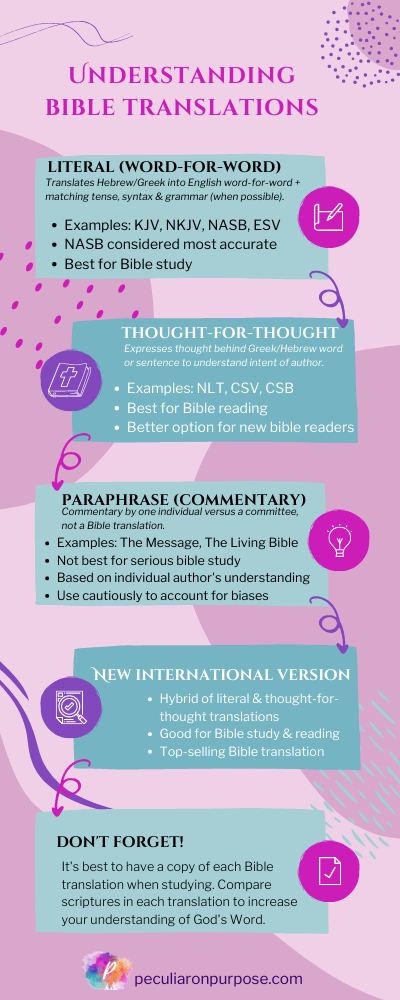
Most of us know we need to read and study the Bible more, but how many of us have been properly taught how? This thought crossed my mind as I went to look up a scripture in my YouVersion app and realized it read differently than how it was written in the devotion I was reading.
As I cross referenced to make sure this wasn’t the devotion author’s paraphrasing, I realized the issue: translations.
There are so many different Bible translations, and it can be easy to feel overwhelmed if you don’t fully understand their purpose. You’ve undoubtedly heard of the King James Version (KJV), but try reading it for two minutes and that will be the end of your study time. And what about the New International Version (NIV)? Your pastor at church usually teaches with it, so does that mean it’s the best for studying? Or is that the New Living Translation (NLT)?
See what I mean?
So, to help us get more out of our Bible study, I’ve teamed up with the Senior Pastor of Mount Calvary Missionary Baptist Church in Tucson, AZ, Marvin Hugley Sr., to learn more about this great book we’re called to know and love. This is part one in a series on Bible translations, how to choose a Bible, and Bible study tools and resources. Ready to jump in?
Understanding Bible Translations
Before we dive into Bible translations, we need to understand why they exist. The original Bible wasn’t written in English. The Old Testament, which consists of 39 books, was written mostly in Hebrew with portions of Ezra and Daniel written in Aramaic. The New Testament, which includes 27 books, was written in Greek. Therefore, the Bible would need to be translated in order for those who don’t speak those languages to understand God’s Word.
Data shows that the full Bible has been translated into more than 700 languages around the world, with the New Testament alone being translated into nearly 1,600 different languages. And within the different languages you can find numerous versions of the Bible. The current YouVersion Bible app offers 2,696 versions. Talk about options.
So, why are there so many different translations of the Bible? Well, according to Pastor Hugley (and tons of data) as bible scholars and researchers discover more biblical records and manuscripts, they then attempt to translate these findings into English (which of course can be translated into another language).
And with all the new discoveries and updates, I am sure you’re wondering about accuracy and errors. As students of God’s Word, we will better prepare our hearts to understand and receive if we remember two things:
1) The Bible is absolutely God’s Word and it is without error. It was written by 40 different authors over the span of 1,500 years. Yet, it contains no contradictions by the various authors because they were each guided by a single author—God. Down through the centuries, scribes, or professional copyists, copied scripture by hand to make more Bibles. This may account for subtle differences in manuscripts (see point 2 below). Yet, the reliability of scripture has not been compromised and we can trust that God has protected his word.
2) Translations may include or exclude certain stories or text based on the manuscripts (the copies that have been made) that are used for translating. For example, the manuscripts used to translate the King James Version and New King James Version (NKJV) are not the same manuscripts used to translate the NIV. Therefore, some stories or text may be either missing altogether in the NIV or placed in the footnotes section. An example of this can be found in John 7:53-8:11, which is the story of the woman caught in adultery. The NIV indicates that this story is not found in the earliest manuscripts.

Methods of Translations
We’ve covered the why, so now it’s time to focus on how. As we better understand how Bible translations work, we can also discover how to best use them when reading scripture. Below are four common ways the Bible is translated:

Literal: this method is also known as word-for-word or formal equivalence. This translation attempts to translate the Hebrew/Greek into English word-for-word including matching tense, syntax and grammar when possible. Some key points about this translation include:
- KJV, NKJV, New American Standard Bible (NASB), and English Standard Version (ESV) are all examples of literal translations.
- NASB is considered the most accurate English translation.
- ESV has become very popular in recent years.
- Literal translation is the best Bible translation for Bible study. It is not the best for Bible reading because sometimes scriptures do not literally translate well from one language to another, causing possible awkward sentence structures.
- You should use caution when giving a literal translation to a beginner Bible reader.
Thought-for-Thought: this method is also known as dynamic equivalence. This translation method does not try to match Hebrew/Greek word-for-word with English, but it attempts to express the thought behind the Greek/Hebrew word or sentence (instead of the literal translation). Some key points about this translation include:
- NLT, New Century Version (NCV), and Christian Standard Bible (CSB) are all examples of thought-for-thought translations.
- This translation seeks to help you understand the intent of the author while trying to offer a simple, up-to-date English understanding.
- Thought-for-thought is the best Bible translation for reading (and beginners).
Paraphrase: this method is not a translation of the Bible, but a commentary of the Bible. Literal and thought-for-thought translations are translated by a committee whereas a paraphrase is commentary by a single individual. Some key points about this method include:
- The Message (written by Eugene Peterson) and The Living Bible (written by Kenneth Taylor) are examples of paraphrase Bibles.
- Paraphrase commentaries are not best for serious Bible study because the author could be biased to his/her understanding of God’s Word.
- Paraphrase commentaries must be used cautiously because they are simply someone else’s interpretation. Their goal is not to be a literal or thought-for-thought translation.
NIV: this Bible translation is considered a thought-for-thought translation, but it is unique because it’s a hybrid of literal and thought-for-thought. The NIV gives you the best of both worlds. It will translate literal when best for understanding, but also translate thought-for-thought when best for understanding. Some key points about the NIV include:
- The NIV is the top-selling Bible translation.
- It is a good Bible for both reading and studying.
Prayerfully all of this information will help you better understand Bible translations and how they affect your reading and comprehension of the Word. Stay tuned for part 2 of this series where we will discuss how to choose a Bible and give an overview of the many different Bible types available.


